
The Atlantic Coast Line Railroad Station was a Atlantic Coast Line Railroad station in Lake Wales, Florida. On August 31, 1990, it was added to the U.S. National Register of Historic Places. The building is now used by the Lake Wales History Museum.

Osceola station is an Amtrak intercity train station in Osceola, Iowa, United States served by Amtrak. Osceola is the closest Amtrak station to Des Moines, Iowa's capital and most populous city, which is about 50 miles (80 km) to the north. The station is listed on the National Register of Historic Places as Chicago, Burlington and Quincy Depot.

West Concord station is an MBTA Commuter Rail station located in West Concord, Massachusetts. It is served by the Fitchburg Line. The station has two side platforms serving the line's two tracks, with mini-high platforms for accessibility. The adjacent station building, now a restaurant, is not used for railroad purposes.

The Atchison, Topeka and Santa Fe Passenger and Freight Complex is a nationally recognized historic district located in Fort Madison, Iowa, United States. It was listed on the National Register of Historic Places in 1992. At the time of its nomination it contained three resources, all of which are contributing buildings. The buildings were constructed over a 24-year time period, and reflect the styles that were popular when they were built. The facility currently houses a local history museum, and after renovations a portion of it was converted back to a passenger train depot for Amtrak, which opened on December 15, 2021.

Barnesville station is a historic train station in Barnesville, Ohio. It is located at 300 East Church Street, between Mulberry and Railroad Streets. The building was placed on the National Register of Historic Places on August 8, 1985, as the Barnesville Baltimore and Ohio Railroad Depot.

The Frisco Depot and adjacent Antlers Spring are historic sites in Antlers, Oklahoma, United States. The sites are a part of the National Register of Historic Places, in which they appear as a single entry.
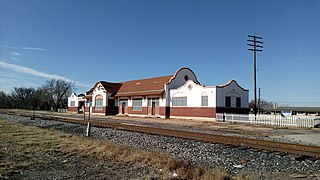
The Rock Island Depot is located in Enid, Garfield County, Oklahoma and listed on the National Register of Historic Places since 1979.
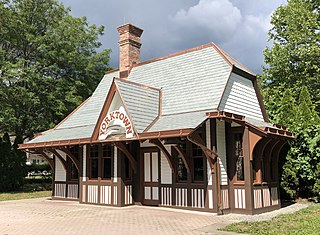
Yorktown Heights station is a former railroad station on the Putnam Line in Yorktown Heights, New York, United States. It is a wooden building located on Commerce Street at the intersection of Underhill Avenue in Railroad Park.

The James A. Redden Federal Courthouse, formerly the United States Post Office and Courthouse, is a federal courthouse located in Medford, Jackson County, Oregon, United States. Completed in 1916 under the supervision of architect Oscar Wenderoth, it houses the United States District Court for the District of Oregon. A substantial extension was completed in 1940, under the supervision of architect, Louis A. Simon. In September 1996, the United States Senate enacted a bill introduced by Oregon Senator Mark Hatfield to rename the building for long-serving District Court judge James A. Redden.

Bemidji station is a former Great Northern Railway depot in Bemidji, Minnesota, United States. It opened in 1913, replacing a wooden structure built in 1898. It was the last depot commissioned by railroad magnate James J. Hill.
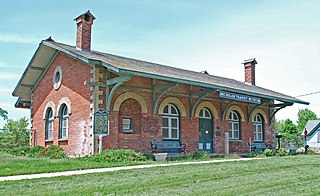
Mount Clemens station is a historic railroad depot located at 198 Grand Street in Mt. Clemens, Michigan. Thomas Edison learned telegraphy at this station in his youth. The building was listed on the National Register of Historic Places in 1981 as the Grand Trunk Western Railroad, Mount Clemens Station and designated a Michigan State Historic Site in 1973. It is now operated as the Michigan Transit Museum.

The Nevada–California–Oregon Railway Passenger Station is a historic train station in Lakeview, Oregon, United States. It was built in 1912 by contractor I. A. Underwood from plans by architect Frederic DeLongchamps. It was the northern terminus of the Nevada–California–Oregon Railway. The Southern Pacific Railroad company owned and operated the depot from 1928 until 1975, when it was closed. Since 1978, the building has been used as a law office and later a private residence. Because of its importance to local history, the depot was listed on the National Register of Historic Places in 1983.

Clayton Railroad Station is a historic railway station located at Clayton, Kent County, Delaware. It was built about 1855, and is a one-story, five-bay, brick, Italianate-style building. It as a low hip roof which extends about three feet from the building forming an overhang. It was built by the Delaware Railroad and remained in use as a passenger service into the 1950s. It later housed an antique shop.

Calhan Rock Island Railroad Depot is a historic railroad station located in Calhan, Colorado, United States. The Chicago, Rock Island and Pacific Railroad provided transportation between Colorado Springs and Kansas until it went into bankruptcy in the early 1970s. The depot, built in 1906, still stands on its original site. The rails were removed and sold for scrap by 1994.

The Greenback Depot is a former railroad station located in Greenback, Tennessee, United States. Built in 1914 by the Louisville and Nashville Railroad (L&N), the depot served rail freight and passengers traveling in and out of the Greenback area until 1954. Restored for use as a community events center by Ronald Edmondson in the early 2010s, the depot was listed on the National Register of Historic Places in 2013 in recognition of its role in the area's transportation history.

The Stillwater Santa Fe Depot is a former railroad station located at 400 East 10th Street in Stillwater, Oklahoma. It served as a rail depot for the Santa Fe Railroad from 1900 until 1958. Now listed on the National Register of Historic Places, it is an example of adaptive re-use of a historic building, serving as the national headquarters for the Kappa Kappa Psi fraternity and Tau Beta Sigma sorority.

Keokuk Union Depot is a historic train station on the west bank of the Mississippi River near downtown Keokuk, Iowa, United States. It was built from 1890 to 1891, and it was listed on the National Register of Historic Places in 2013.

The Rock Island Passenger Depot is a historic building located in Oskaloosa, Iowa, United States. The Chicago, Rock Island & Pacific Railroad arrived in town in 1876, and they built a frame combination depot on the north side of the tracks. This depot replaced the original one in 1888 on the south side of the tracks, and it served ten passenger trains a day. A separate freight depot was built to the east. President Theodore Roosevelt stopped here when he came to dedicate the new Y.M.C.A. in 1903. The freight and passenger depots were combined into a single facility once again in 1930, utilizing the passenger depot. The depot was officially abandoned in 1973. It was listed on the National Register of Historic Places in 1989. The building now houses a pub.
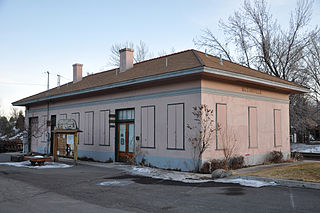
The Susanville Railroad Depot is a National Register of Historic Places property in Lassen County, California in the city of Susanville. Originally constructed for the Fernley and Lassen Railway in 1927 to replace an existing station building, it was closed in 1979, and in 1987 it was saved from being burnt by the fire department after local protests, being purchased instead by the Lassen Land and Trails Trust, which uses it for their office as well as maintaining a small museum.
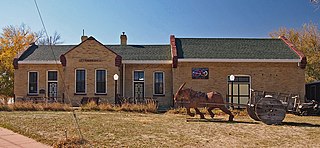
The Burlington Cedar Rapids and Northern Depot is a historic railroad depot in Pipestone, Minnesota, United States, constructed by the Burlington, Cedar Rapids and Northern Railway in 1890. Later, the line would become a branch of the Chicago, Rock Island, and Pacific Railroad. The depot consists of a freight room, a ticket office and separate men's and women's waiting rooms.






















